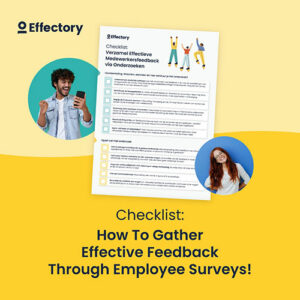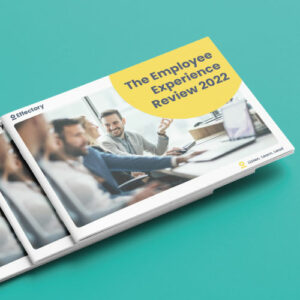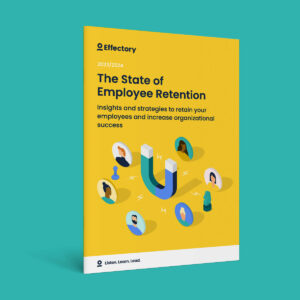Employee engagement and employee motivation are very similar, but they don’t mean the same thing. Engagement is a sense of purpose, belonging, and commitment to an organization, whereas motivation is the willpower and drive to act on those feelings. Employee engagement serves as a foundation for your employees to do their best work, while motivation is the fuel or energy required to actually do it.
Engagement and Motivation: what is the difference?

Implement an employee engagement strategy that motivates your team to be more productive.
Engagement and motivation each have significant impacts on business outcomes. According to Globoforce, almost 80 percent of employees report being more productive when recognition and rewards are used to motivate them. As for engagement, Gallup found that the businesses and teams that scored in the top quartile on employee engagement are 22 percent more profitable than those in the bottom quartile.
The return on investment of employee feedback & engagement: a success story
The key to unlocking an employee’s full potential is creating a work environment where team members are both engaged and motivated. The two concepts often work hand-in-hand, but for best results, managers should distinguish between the two. Some management and HR strategies address both simultaneously, but to effectively execute these initiatives, you need to understand how engagement and motivation play out differently within your organization.
In this article, we will explore different types of engagement and motivation, and we’ll outline strategies for making each one a part of your employee engagement plan.
How HR can lead business success
HR and employee listening are crucial to business success. Here is how employee insights can help your organization.
DownloadWhat is employee engagement?
Employee engagement characterizes the relationship between organizations and their employees. Engagement metrics measures employee commitment and dedication to the company, its values, and its central mission. First coined in the early 1990s by professor of organizational behavior William Kahn, employee engagement has been embraced by many organizations today who have embedded it into their HR initiatives and overall strategy for improving business outcomes.
Multiple employee experience and perspective factors go into measuring engagement including:
Pride in the organization: Employees who believe in the company’s values are more likely to be invested in its central mission and to act as brand ambassadors.
Leadership: Engagement starts at the top. When leaders are present and involved in daily efforts, employees are inspired to contribute to the collective goal.
Management style: How managers and employees interact and relate has a major impact on engagement. Managers need to provide their team with support and guidance to keep them engaged.
Advancement opportunities: When employees can see a clear path for advancement ahead of them, investing in the organization and in themselves become synonymous.
Autonomy and resources: Engagement increases when employees are given the right tools to do their jobs. Clearly-defined responsibilities and metrics for success empower employees to work autonomously, which fosters a sense of satisfaction in their work.
Well-being: When organizations invest in their employees’ physical and mental health and promote balance between employees’ work and personal lives, employees are more likely to commit to the organization.
Office culture: Employees form stronger connections with their organization as a whole when they bond individually with coworkers, and engagement increases when there is a genuine sense of community in an organization.
Diversity: The strong link between diversity and employee engagement indicates that diverse teams are collaborative and committed and that employees are more likely to feel proud of an organization that is inclusive.
When employees are engaged, productivity increases, turnover is reduced, and there are even fewer employee mistakes and accidents on the job. In contrast, disengaged employees can cost national economies billions every year.
Employee Engagement: The 20 best survey questions
How to gather feedback from your employees
The definitive checklist for creating your employee engagement survey.
DownloadWhat is employee motivation?
There are two kinds of motivation: intrinsic and extrinsic. Managers need to understand the difference and provide both types to effectively motivate employees.
Intrinsic motivation
Intrinsic motivation is the internal drive an employee feels. When employees are intrinsically motivated, performing their work roles is inherently satisfying to them. Satisfaction might take the shape of overcoming a challenge, enthusiasm for the work itself, or a sense of pride in contributing to a worthy goal.
Because emotional connection and satisfaction overlap, intrinsic motivation is the type of motivation most commonly associated with employee engagement. A properly executed engagement strategy should provide employees with intrinsic motivators. Meaningful work, access to necessary resources, and clearly defined metrics for success all foster intrinsic motivation in employees.
Five employee engagement models every HR professional need to know
Extrinsic motivation
Extrinsic motivation is generated through the external factors that drive an employee. Extrinsic motivators can be short-term, like a prize for a top-performing employee of the month, or long-term, such as a prospective raise or promotion. Because extrinsic motivation is connected with specific, tangible outcomes, however, efficacy tends to be temporary. That means managers need to continuously re-evaluate and update extrinsic motivators.
Extrinsic motivators can significantly improve productivity under certain conditions, but only when used in moderation. For example, a company could use overtime pay to encourage meeting a tight deadline or seasonal demand. According to SHRM, incentive and recognition programs reduce attrition and improve customer service, among other positive business outcomes.
A word of caution: punishments or the withholding of a positive motivator are examples of negative motivation, for instance, reprimands from a manager or the loss of an expected raise or promotion. Negative motivators may positively impact productivity in the short term, but are detrimental to employee engagement and tend to increase attrition in the long term. They should be used sparingly in the workplace, if ever.
Download the Employee Experience Review
Discover how employees around the world are experiencing different parts of the employee journey and how this affects the employee experience.
DownloadEngagement and motivation at work
Remember, engagement and motivation are different.
You could have a highly motivated employee in your organization who is not actively engaged. That’s a problem because motivated, disengaged employees are likely to leave the company in search of better opportunities, or simply another employer with better engagement practices.
You could also have an employee who is engaged but not motivated. They have formed bonds at work and believe in the overall mission, but there’s no direct incentive for them to contribute as an individual when they already derive a sense of accomplishment from group initiatives.
Ideally, employers should use employee engagement strategies that include extrinsic positive motivators while also creating the right conditions for intrinsic motivation.
Generate intrinsic motivation
Get to know your employees’ interests
Employees are more motivated to work on projects they are genuinely interested in. Managers need to spend time learning about their team’s skills and interests to know which tasks are best suited to each team member. Employees should be able to play to their strengths. Give them opportunities to grow and learn that benefit the company.
Encourage personal projects
Industry leaders recognize how important it is to let their employees explore. Companies like 3M and Google allocate a certain percentage of employee time to employee pet projects. The initiative has not only provided intrinsic motivation, but historically resulted in major products like Gmail and Adsense.
Put every task into broader context
Employees work harder when they know their work matters. A great way to encourage intrinsic motivation is to tie all assignments, no matter the size, to a larger mission or vision. When an employee understands the big picture and their role in it, their work takes on greater significance and becomes more satisfying.
Tailor the work to the employee’s career stage
Motivation is personal, even when you are working toward a collective goal. For instance, a new hire fresh out of university is likely motivated by very different factors than an employee three years away from retirement. Identifying what drives employees—both day-to-day and in the long term—makes it much easier to figure out which work will motivate them the most.
The State of Employee Retention
Uncover why employees leave, hidden costs to organizations, and proven retention strategies in our insightful report.
DownloadCreate extrinsic motivation
Provide specific guidelines for incentives
While a monthly prize draw might be a cost-effective way to reward top performers, it’s not a very strong motivator because they still need to rely on luck to get the reward they’ve been working toward. Incentive programs should be clearly outlined with inarguable benchmarks so that employees have something to aim for with a guaranteed outcome.
Praise employees on their terms
Some employees like public recognition while others respond best to direct feedback from their manager out of the spotlight. Whether you’re motivating your employee with praise or a gift, give them some flexibility as to how they are rewarded. If you are rewarding employees with a physical item, have three options for them to choose from.
Reward employees with improved workplace experience
Now more than ever, employees are looking for flexible hours and remote work options. Managers should be looking for opportunities to reward top performers with more control over their own time and workload. Ideas: Employees always appreciate additional vacation days, or, depending on the industry, top performers could also be given their choice on which upcoming project to work on.
Celebrate milestones
When talking about extrinsic motivators, we often focus on performance and productivity-based incentives. According to SHRM, the total costs related to turnover in a role range from 90% to 200% of the employee’s annual salary. Offering extra perks to those who stay with the company long-term is a great way to combat turnover (and attract top talent to begin with). This may be a much better option than raises, which employees expect.
Employee engagement and motivation both have a major effect on a company’s bottom line, whether that’s a positive or negative impact. HR, managers, and team leaders need to work together to set employees up for success with initiatives that keep teams engaged and motivated. By implementing a well-researched engagement strategy and using the right tailored incentive programs, organizations can improve productivity, reduce turnover, and even encourage their employees to generate new business ideas.
Book a free demo. See our solutions in action.
Effectory is Europe’s Leading provider of Employee Listening Solutions. Schedule a product demo and discover how to enhance your employees’ engagement.
Demo request



